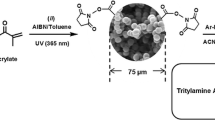Abstract
A generalized preparation protocol for open tubular (OT) molecular imprinted polymer (MIP) silica capillary columns for chiral separations in capillary electrochromatography (CEC) is described. For different chiral molecules the same general composition of the MIP reaction mixture can be used except for the choice of the specific template. This protocol is valid for a variety of templates including acidic, basic, and neutral molecules, enabling formation of rugged and porous thin MIP layers on the inner surface of the capillary resulting in columns with high chiral separation efficiencies if the template has a good chiral recognition susceptibility.
Access this chapter
Tax calculation will be finalised at checkout
Purchases are for personal use only
Similar content being viewed by others
References
Sellergren B (ed) (2001) Molecularly Imprinted Polymers: Man-made Mimics of Antibodies and Their Applications in Analytical Chemistry. Elsevier, Amsterdam
Yan M, Ramstrom O (eds) (2005) Molecularly Imprinted Materials. Marcel Dekker, New York
Vallano PT, Remcho VT (2000) Highly selective separations by capillary electrochromatography: molecular imprint polymer sorbents. J Chromatogr A 887:125–135
Schweitz L, Spégel P, Nilsson S (2001) Approaches to molecular imprinting based selectivity in capillary electrochromatography. Electrophoresis 22:4053–4063
Spégel P, Schweitz L, Nilsson S (2003) Molecularly imprinted polymers in capillary electrochromatography: Recent developments and future trends. Electrophoresis 24:3892–3899
Liu C, Lin C (2004) An insight into molecularly imprinted polymers for capillary electrochromatography. Electrophoresis 25:3997–4007
Nilsson J, Spégel P, Nilsson S (2004) Molecularly imprinted polymer formats for capillary Electrochromatography. J Chromatogr B 804:3–12
Liu Z, Zheng C, Yan C et al (2007) Molecularly imprinted polymers as a tool for separation in CEC. Electrophoresis 28:127–136
Liu H, Row KH, Yang G (2005) Monolithic Molecularly Imprinted Columns for Chro-matographic Separation. Chromatographia 61: 429–432
Haginaka J (2008) Monodispersed, molecularly imprinted polymers as affinity-based chromatography media. J Chromatogr B 866:3–13
Haginaka J (2009) Molecularly imprinted polymers as affinity-based separation media for sample preparation. J Sep Sci 32:1548–1565
Alvarez-Lorenzo C, Concheiro A (2004) Molecularly imprinted polymers for drug delivery. J Chromatogr B 804:231–245
Maier NM, Lindner W (2007) Chiral recognition applications of molecularly imprinted polymers: a critical review. Anal Bioanal Chem 389:377–397
Lee W, Cheng C, Pan H et al (2008) Chromatographic characterization of molecularly imprinted polymers. Anal Bioanal Chem 390:1101–1109
Swart R, Kraak JC, Poppe H (1995) Performance of an ethoxyethylacrylate stationary phase for open-tubular liquid chromatography. J Chromatogr A 689:177–187
Luo Q, Yue G, Valaskovic GA et al (2007) On-Line 1D and 2D Porous Layer Open Tubular/LC-ESI-MS Using 10-μm-i.d. Poly(styrene-divinylbenzene) Columns for Ultrasensitive Proteomic Analysis. Anal Chem 79:6174–6181
Yue G, Luo Q, Zhang J et al (2007) Ultratrace LC/MS Proteomic Analysis Using 10-μm-i.d. Porous Layer Open Tubular Poly(styrene-divinylbenzene) Capillary Columns. Anal Chem 79:938–946
Brϋggermann O, Freitag R, Whitcombe MJ et al (1997) Comparison of polymer coatings of capillaries for capillary electrophoresis with respect to their applicability to molecular imprinting and electrochromatography. J Chromatogr A 781:43–53
Tan ZJ, Remcho VT (1998) Molecular imprint polymers as highly selective stationary phases in open tubular liquid chromatography and capillary electrochromatography. Electro-phoresis 19:2055–2060
Schweitz L (2002) Molecularly Imprinted Polymer Coatings for Open-Tubular Capillary Electrochromatography Prepared by Surface Initiation. Anal Chem 74:1192–1196
Huang YC, Lin CC, Liu CY (2004) Preparation and evaluation of molecularly imprinted polymers based on 9-ethyladenine for the recognition of nucleotide bases in capillary electrochromatography. Electrophoresis 25: 554–561
Zaidi SA, Cheong WJ (2009) Preparation of an open-tubular capillary column with a monolithic layer of S-ketoprofen imprinted and 4-styrenesulfonic acid incorporated polymer and its enhanced chiral separation performance in capillary electrochromatography. J Chromatogr A 1216:2947–2952
Zaidi SA, Cheong WJ (2008) Robust open tubular layer of S-ketoprofen imprinted polymer for chiral LC separation. J Sep Sci 31: 2962–2970
Zaidi SA, Cheong WJ (2009) Long open tubular molecule imprinted polymer capillary columns with excellent separation efficiencies in chiral and nonchiral separation by capillary electrochromatography. Electrophoresis 30: 1603–1607
Zaidi SA, Han KM, Kim SS et al (2009) Open tubular layer of S-ofloxacin imprinted polymer fabricated in silica capillary for chiral CEC separation. J Sep Sci 32:996–1001
Zaidi SA, Han KM, Hwang DG et al (2010) Preparation of open tubular molecule imprinted polymer capillary columns with various templates by a generalized procedure and their chiral and non-chiral separation performance in CEC. Electrophoresis 31:1019–1028
Zaidi SA, Lee SM, Lee JY et al (2010) Comparison of Enantioselective CEC Separation of OT-MIP Capillary Columns with Templates of Various Camphor Derivatives Made by the Pre-established General Preparation Protocol. Bull Korean Chem Soc 31:2934–2938
Zaidi SA, Lee SM, Cheong WJ (2011) Open tubular capillary columns with basic templates made by the generalized preparation protocol in capillary electrochromatography chiral separation and template structural effects on chiral separation capability. J Chromatogr A 1218: 1291–1299
Zaidi SA, Lee SM, Othman AL, ZA et al. (2011) Examination of Template Structural Effects on CEC Chiral Separation Performance of Molecule Imprinted Polymers Made by a Generalized Preparation Protocol. Chro-matographia 73:517–525
Acknowledgments
This work was supported by Basic Science Research Program through the National Research Foundation of Korea (NRF) funded by the Ministry of Education, Science and Technology (2011–0003107).
Author information
Authors and Affiliations
Corresponding author
Editor information
Editors and Affiliations
Rights and permissions
Copyright information
© 2013 Springer Science+Business Media, LLC
About this protocol
Cite this protocol
Cheong, W.J., Yang, S.H. (2013). Open Tubular Molecular Imprinted Phases in Chiral Capillary Electrochromatography. In: Scriba, G. (eds) Chiral Separations. Methods in Molecular Biology, vol 970. Humana Press, Totowa, NJ. https://doi.org/10.1007/978-1-62703-263-6_30
Download citation
DOI: https://doi.org/10.1007/978-1-62703-263-6_30
Published:
Publisher Name: Humana Press, Totowa, NJ
Print ISBN: 978-1-62703-262-9
Online ISBN: 978-1-62703-263-6
eBook Packages: Springer Protocols




